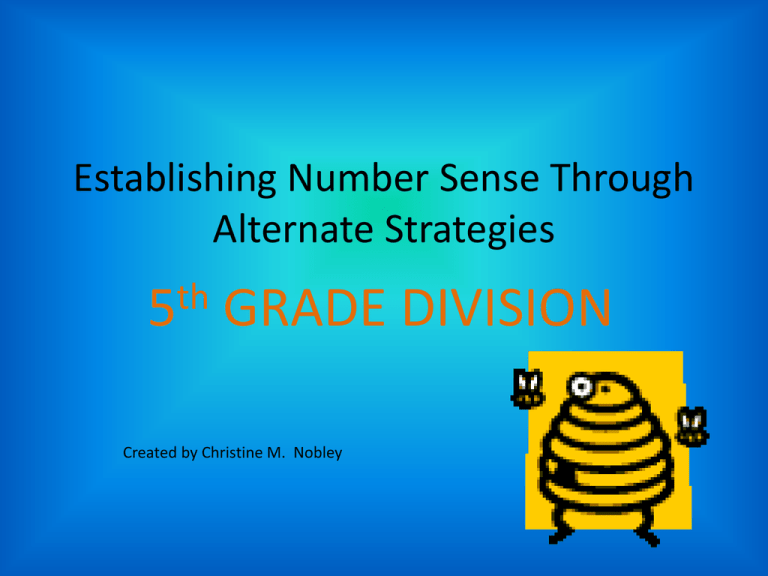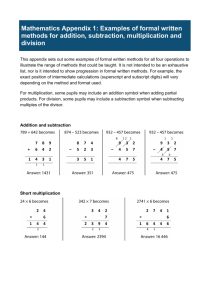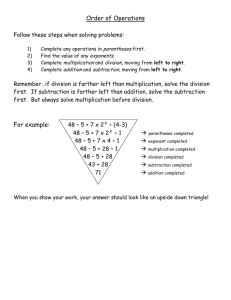Division Strategy PPT
advertisement

Establishing Number Sense Through Alternate Strategies th 5 GRADE DIVISION Created by Christine M. Nobley STANDARDS GPS 2011-2012 CCGPS 2012-2013 M5N3b. Explain the process of division including situations where divisors are whole numbers and decimals. MCC5.NBT.6 Find the whole number quotients of whole numbers with up to 4 digit dividends and 2 digit divisors using strategies based on place value, the properties of operations, and/or the relationship between multiplication and division. “Students with good number sense can think and reason flexibly with numbers, use numbers to solve problems, spot unreasonable answers, understand how numbers can be taken apart and put together in different ways, see connections among operations, figure mentally, and make reasonable estimates”. Burns, M. (2007) DEALING OUT (SHARING) by one 30 5 I I I I I I I I I I I I I I I I I I I I I I I I I I I I I I I I I I I I I I I I I I I I I 2 2 2 2 2 2 2 2 2 2 2 2 2 2 2 DEALING OUT By multiples 30 5 REPEATED ADDITION • Uses existing addition skills • Helps with multiplication skills • Limited view of division 0 3 6 9 18 3 12 3+3+3+3+3+3 15 18 REPEATED SUBTRACTION • Uses existing subtraction skills • Most kids not as proficient in subtraction 18 18 15 12 3 9 6 3 0 84 6 • Divide 6 into 8, subtract, get 2, bring down 4? • 6 X 10= 60 6 X 4= 24 14 • ½ of 84 = 42 ½ of 6= 3 42 3 = 14 so 84 6 = 14 • Half of 84 is 42. 42 divided by 6 = 7. 7 X 2= 14. COUNTING ON • Uses knowledge of addition or subtraction • Large numbers time consuming 6 12 18 24 30 36 42 48 54 60 66 72 78 84 HALF THEN DOUBLE • Can only use if dividend is even 24 4 12 4 = 3 Double that = 6 108 6 54 6 = 9 Double that = 18 8662 41 4331 41 Clearly, this strategy is not helpful. 91 Strategy not helpful because 91 is odd 7 PROPORTIONAL REASONING 100 50 = 2 50 25 = 2 10 5 = 2 2 1=2 48 24 8 4 12 = 4 6=4 288 16 144 8 72 4 36 2 = 18 2=4 1=4 SINGLE DIGIT ARRAYS • Shows how to build up to the dividend • Uses existing multiplication knowledge 7 300 7 7 300 10 10 10 10 2 70 70 70 70 14 6 left over 3 DIGIT BY 2 DIGIT ARRAY 884 26 26 10 10 10 2 2 260 260 260 52 52 MULTIPLYING UP • Builds on strengths in multiplication • Relates multiplication to division 960 15 x 10 = 150 15 x 10 = 150 15 x 10 = 150 15 x 10 = 150 15 x 10 = 150 15 x 10 = 150 15 x 4 = 60 15 15 x 20 = 300 15 x 20 = 300 15 x 20 = 300 15 x 2 = 30 15 x 2 = 30 15 x 30 = 450 15 x 30 = 450 15 x 4 = 60 DISTRIBUTIVE PROPERTY 65 (30 + 30 + 5) 6 + 6 + 1 5 645 5 20 (600 + 40 + 5) 30 + 2 = 32 = 13 132 12 (120 + 12) 120 12 12 12 10 + 12 1 = 11 R5 PARTIAL QUOTIENTS • Uses friendly multiplication facts • x2 • x5 • x 10 18 468 - 180 288 - 180 108 - 90 18 - 18 0 10 10 5 1 Answer = 26 PARTIAL QUOTIENT • http://www.youtube.com/watch?v=qWstA8EZ r2w STANDARD ALGORITHM 177 5 885 -5 38 -35 35 -35 0 Divide Multiply Subtract Bring Down REVIEW OF DIVISION STRATEGIES 1. Dealing Out/Sharing 2. Repeated Addition 3. Repeated Subtraction 4. Counting Up 5. Half then Double 6. Proportional Reasoning 7. Rectangular Arrays 8. Multiplying Up 9. Distributive Property 10. Partial Quotients “By abandoning the rote teaching of algorithms we are not asking children to learn less, we are asking them to learn more” (Fosnot & Dolk, 2001, p.102). References Burns, M. (2007). About teaching mathematics: a k-8 resource (3rd ed.). Sausalito, Ca: Scholastic, Inc. Chapin, S., & Johnson, A. (2000). Math matters: grades k-6. Sausalito, Ca: Math Solutions Publications. Fosnot, C. T., & Dolk, M. (2001). Mathematicians at work: Constructing multiplication and division. Portsmouth, NH: Heinemann. Hickendorff, M., van Putten, C., Verhelst, N., & Heiser, W. (2010). Individual differences in strategy use on division problems: mental versus written computation. Journal of Educational Psychology, 102(2), 438-452. Mulligan, J., & Mitchelmore, M. (1997). Young children's intuitive models of multiplication and division. Journal for Research in Mathematics Education, 28(3), 309-331. Partial quotients method for division. (August 26, 2009). Retrieved June 21, 2012 from http://www.youtube.com/watch?v=qWstA8EZr2w HOW CAN I PRACTICE? • • • • • • • • • • http://www.sophia.org/partial-quotients-algorithm-tutorial http://www.slideshare.net/guestb30cd4/partial-quotients http://www.williston.k12.sc.us/kees/KEES%20Curriculum/MAPLessonPlans/Num&Oper/221230/Day08.pdf http://teachmath.openschoolnetwork.ca/wordpress/grade-5/division/distributive-propertyfor-division/ http://www.youtube.com/watch?v=4o_5PUZ4wvU http://eternaltreasures.hubpages.com/hub/MATHEMATICS-Shortcuts-in-MultiplicationDivision-Addition-Subtraction-secrets-in-mental-math-calculation-speed http://www.teachertube.com/viewVideo.php?title=Partial_Quotients_Division&video_id=20 032 http://www.youtube.com/watch?v=By9Kwoz8oT4 5 http://www.youtube.com/watch?v=340UK0aox1I http://www.youtube.com/watch?v=FJ-P5c_bZlc http://www.youtube.com/watch?v=hCKd3C4P6Uk



